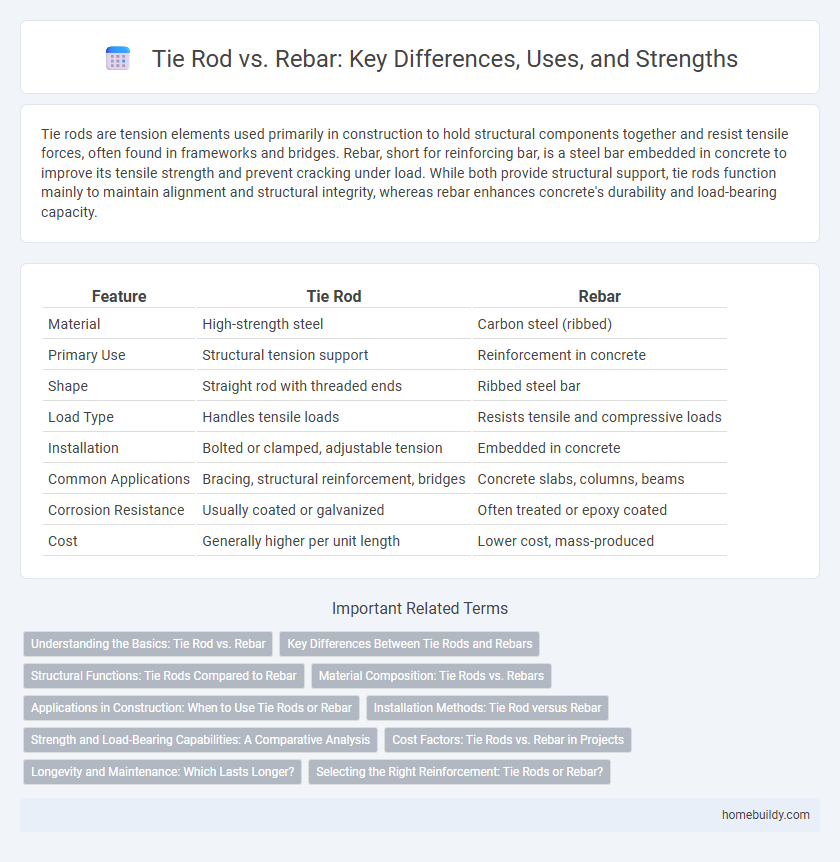Tie rods are tension elements used primarily in construction to hold structural components together and resist tensile forces, often found in frameworks and bridges. Rebar, short for reinforcing bar, is a steel bar embedded in concrete to improve its tensile strength and prevent cracking under load. While both provide structural support, tie rods function mainly to maintain alignment and structural integrity, whereas rebar enhances concrete's durability and load-bearing capacity.
Table of Comparison
| Feature | Tie Rod | Rebar |
|---|---|---|
| Material | High-strength steel | Carbon steel (ribbed) |
| Primary Use | Structural tension support | Reinforcement in concrete |
| Shape | Straight rod with threaded ends | Ribbed steel bar |
| Load Type | Handles tensile loads | Resists tensile and compressive loads |
| Installation | Bolted or clamped, adjustable tension | Embedded in concrete |
| Common Applications | Bracing, structural reinforcement, bridges | Concrete slabs, columns, beams |
| Corrosion Resistance | Usually coated or galvanized | Often treated or epoxy coated |
| Cost | Generally higher per unit length | Lower cost, mass-produced |
Understanding the Basics: Tie Rod vs. Rebar
Tie rods are tension members used primarily to resist tensile forces in structures, often made from steel bars or rods, while rebars are reinforced steel bars primarily embedded in concrete to enhance its compressive strength. Tie rods provide structural stability by preventing components from separating under tension, whereas rebars increase the load-bearing capacity of concrete by distributing stress and controlling cracking. Understanding these fundamental differences helps in selecting the appropriate material for construction applications where either tension reinforcement or concrete reinforcement is required.
Key Differences Between Tie Rods and Rebars
Tie rods are slender steel bars primarily used to resist tensile forces and prevent structural components from spreading, while rebars (reinforcing bars) are thicker and embedded in concrete to provide compressive strength and enhance overall structural integrity. Tie rods are typically tensioned and external to the main concrete structure, whereas rebars are internal elements designed to improve concrete's low tensile strength. The distinct applications and mechanical properties make tie rods ideal for tension support, whereas rebars serve as reinforcement within concrete frameworks.
Structural Functions: Tie Rods Compared to Rebar
Tie rods primarily provide tension support in structural frameworks, effectively resisting tensile forces to maintain stability. Rebar, composed of steel reinforcing bars, primarily enhances concrete's compressive strength by preventing cracking and supporting load distribution. While tie rods stabilize structures through direct tension, rebar reinforces concrete under compression, making their roles complementary in construction engineering.
Material Composition: Tie Rods vs. Rebars
Tie rods are typically made from high-strength steel alloys with precise tensile properties designed for tension support in structural frameworks. Rebars, on the other hand, consist primarily of carbon steel with ribbed surfaces to enhance bonding with concrete, optimizing compressive reinforcement. The distinct material composition of tie rods enables superior tensile stress resistance, while rebars focus on compressive reinforcement within concrete structures.
Applications in Construction: When to Use Tie Rods or Rebar
Tie rods provide tension support in structural frameworks, making them ideal for bracing and stabilizing frameworks in bridges and large steel structures. Rebar is primarily used to reinforce concrete, enhancing its tensile strength in slabs, beams, and columns for buildings and infrastructure projects. Choosing between tie rods and rebar depends on whether tension support or concrete reinforcement is required for the specific construction application.
Installation Methods: Tie Rod versus Rebar
Tie rods install with a simpler process, typically requiring threading and tensioning to secure structural elements, while rebar installation involves precise cutting, bending, and tying before concrete pouring. Tie rods offer quicker adjustment on-site, reducing labor time compared to the fixed placement of rebar that often demands detailed positioning and formwork integration. The installation efficiency of tie rods makes them preferable in applications where tensile force control and rapid assembly are critical.
Strength and Load-Bearing Capabilities: A Comparative Analysis
Tie rods and rebars serve distinct roles in construction with varying strength and load-bearing capabilities. Tie rods provide tensile strength by resisting pulling forces, making them essential for structural stability in frameworks and tension applications. Rebars primarily enhance compressive strength within concrete, distributing loads to prevent cracking and structural failure under heavy weight.
Cost Factors: Tie Rods vs. Rebar in Projects
Tie rods generally offer a lower material cost compared to rebar, making them a cost-effective choice for tension applications in construction projects. Installation expenses vary depending on project complexity, with tie rods often requiring less labor due to simpler handling and fastening techniques. Long-term maintenance costs favor tie rods in environments prone to corrosion as their material composition typically includes protective coatings, reducing replacement frequency compared to traditional rebar.
Longevity and Maintenance: Which Lasts Longer?
Tie rods exhibit superior longevity compared to rebar due to their enhanced resistance to corrosion and structural fatigue, which reduces the frequency of maintenance interventions. Rebar, often embedded in concrete, is susceptible to rust when exposed to moisture, leading to potential structural weaknesses over time. Choosing tie rods can result in longer-lasting durability with lower maintenance demands in construction applications.
Selecting the Right Reinforcement: Tie Rods or Rebar?
Selecting the right reinforcement depends on the structural requirements and load-bearing capacity needed; tie rods offer superior tensile strength and flexibility in tension applications, while rebar excels in compressive strength and provides rigidity in concrete structures. Tie rods are typically used in tension-based frameworks like bridges and roof trusses, whereas rebar is primarily embedded in concrete foundations and slabs to resist compressive forces. Assessing environmental factors and load dynamics is critical to determine whether the tensile durability of tie rods or the compressive reinforcement of rebar best suits the project.
tie rod vs rebar Infographic

 homebuildy.com
homebuildy.com